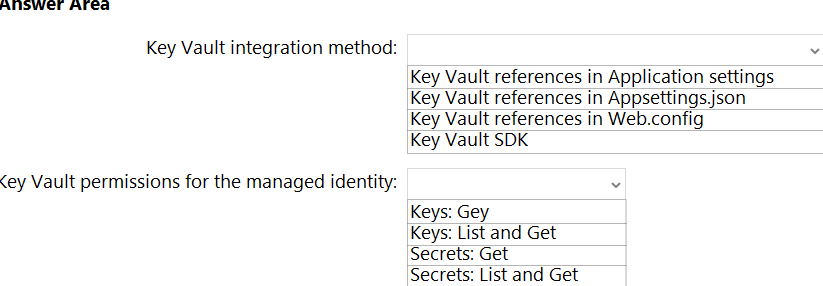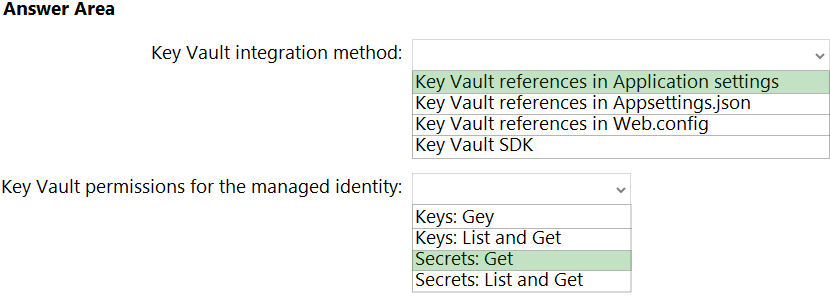microsoft az-305 practice test
Designing Microsoft Azure Infrastructure Solutions
Question 1
You are developing a sales application that will contain several Azure cloud services and handle different components of a transaction. Different cloud services will process customer orders, billing, payment, inventory, and shipping.
You need to recommend a solution to enable the cloud services to asynchronously communicate transaction information by using XML messages.
What should you include in the recommendation?
- A. Azure Notification Hubs
- B. Azure Service Fabric
- C. Azure Queue Storage
- D. Azure Data Lake
Answer:
c
Queue Storage delivers asynchronous messaging between application components, whether they are running in the cloud, on the desktop, on an on-premises server, or on a mobile device.
The maximum message size supported by Azure Storage Queues is 64KB while Azure Service Bus Queues support messages up to 256KB. This becomes an important factor especially when the message format is padded (such as XML).
Reference:
https://docs.microsoft.com/en-us/azure/storage/queues/storage-dotnet-how-to-use-queues https://blog.kloud.com.au/2016/03/01/cloud-cushioning-using-azure-queues/
Question 2
You need to design a highly available Azure SQL database that meets the following requirements:
Failover between replicas of the database must occur without any data loss.
The database must remain available in the event of a zone outage.
Costs must be minimized.
Which deployment option should you use?
- A. Azure SQL Database Business Critical
- B. Azure SQL Managed Instance Business Critical
- C. Azure SQL Database Standard
- D. Azure SQL Managed Instance General Purpose
Answer:
a
Question 3
You have the resources shown in the following table:
CDB1 hosts a container that stores continuously updated operational data.
You are designing a solution that will use AS1 to analyze the operational data daily.
You need to recommend a solution to analyze the data without affecting the performance of the operational data store.
What should you include in the recommendation?
- A. Azure Cosmos DB change feed
- B. Azure Data Factory with Azure Cosmos DB and Azure Synapse Analytics connectors
- C. Azure Synapse Link for Azure Cosmos DB
- D. Azure Synapse Analytics with PolyBase data loading
Answer:
c
Azure Synapse Link for Azure Cosmos DB creates a tight integration between Azure Cosmos DB and Azure Synapse Analytics. It enables customers to run near real-time analytics over their operational data with full performance isolation from their transactional workloads and without an ETL pipeline.
Reference:
https://docs.microsoft.com/en-us/azure/cosmos-db/synapse-link-frequently-asked-questions
Question 4
You are designing an application that will aggregate content for users.
You need to recommend a database solution for the application. The solution must meet the following requirements:
Support SQL commands.
Support multi-master writes.
Guarantee low latency read operations.
What should you include in the recommendation?
- A. Azure Cosmos DB for NoSQL
- B. Azure SQL Database that uses active geo-replication
- C. Azure SQL Database Hyperscale
- D. Azure Cosmos DB for PostgreSQL
Answer:
a
Question 5
You have 100 Microsoft SQL Server Integration Services (SSIS) packages that are configured to use 10 on-premises SQL Server databases as their destinations.
You plan to migrate the 10 on-premises databases to Azure SQL Database.
You need to recommend a solution to create Azure-SQL Server Integration Services (SSIS) packages. The solution must ensure that the packages can target the
SQL Database instances as their destinations.
What should you include in the recommendation?
- A. Data Migration Assistant (DMA)
- B. Azure Data Factory
- C. Azure Data Catalog
- D. SQL Server Migration Assistant (SSMA)
Answer:
b
Migrate on-premises SSIS workloads to SSIS using ADF (Azure Data Factory).
When you migrate your database workloads from SQL Server on premises to Azure database services, namely Azure SQL Database or Azure SQL Managed
Instance, your ETL workloads on SQL Server Integration Services (SSIS) as one of the primary value-added services will need to be migrated as well.
Azure-SSIS Integration Runtime (IR) in Azure Data Factory (ADF) supports running SSIS packages. Once Azure-SSIS IR is provisioned, you can then use familiar tools, such as SQL Server Data Tools (SSDT)/SQL Server Management Studio (SSMS), and command-line utilities, such as dtinstall/dtutil/dtexec, to deploy and run your packages in Azure.
Reference:
https://docs.microsoft.com/en-us/azure/data-factory/scenario-ssis-migration-overview
Question 6
HOTSPOT You have an Azure App Service web app that uses a system-assigned managed identity.
You need to recommend a solution to store the settings of the web app as secrets in an Azure key vault. The solution must meet the following requirements:
Minimize changes to the app code.
Use the principle of least privilege.
What should you include in the recommendation? To answer, select the appropriate options in the answer area.
NOTE: Each correct selection is worth one point.
Hot Area:
Answer:

Box 1: Key Vault references in Application settings
Source Application Settings from Key Vault.
Key Vault references can be used as values for Application Settings, allowing you to keep secrets in Key Vault instead of the site config. Application Settings are securely encrypted at rest, but if you need secret management capabilities, they should go into Key Vault.
To use a Key Vault reference for an app setting, set the reference as the value of the setting. Your app can reference the secret through its key as normal. No code changes are required.
Box 2: Secrets: Get -
In order to read secrets from Key Vault, you need to have a vault created and give your app permission to access it.
1. Create a key vault by following the Key Vault quickstart.
2. Create a managed identity for your application.
3. Key Vault references will use the app's system assigned identity by default, but you can specify a user-assigned identity.
4. Create an access policy in Key Vault for the application identity you created earlier. Enable the Get secret permission on this policy.
Reference:
https://docs.microsoft.com/en-us/azure/app-service/app-service-key-vault-references https://docs.microsoft.com/en-us/azure/app-service/app-service-key-vault-references
Question 7
You plan to migrate App1 to Azure.
You need to recommend a network connectivity solution for the Azure Storage account that will host the App1 data. The solution must meet the security and compliance requirements.
What should you include in the recommendation?
- A. Microsoft peering for an ExpressRoute circuit
- B. Azure public peering for an ExpressRoute circuit
- C. a service endpoint that has a service endpoint policy
- D. a private endpoint
Answer:
d
Private Endpoint securely connect to storage accounts from on-premises networks that connect to the VNet using VPN or ExpressRoutes with private-peering.
Private Endpoint also secure your storage account by configuring the storage firewall to block all connections on the public endpoint for the storage service.
Incorrect Answers:
A: Microsoft peering provides access to Azure public services via public endpoints with public IP addresses, which should not be allowed.
B: Azure public peering has been deprecated.
C: By default, Service Endpoints are enabled on subnets configured in Azure virtual networks. Endpoints can't be used for traffic from your premises to Azure services.
Reference:
https://docs.microsoft.com/en-us/azure/expressroute/expressroute-circuit-peerings
Question 8
You have an app named App1 that uses two on-premises Microsoft SQL Server databases named DB1 and DB2.
You plan to migrate DB1 and DB2 to Azure
You need to recommend an Azure solution to host DB1 and DB2. The solution must meet the following requirements:
Support server-side transactions across DB1 and DB2.
Minimize administrative effort to update the solution.
What should you recommend?
- A. two Azure SQL databases in an elastic pool
- B. two databases on the same Azure SQL managed instance
- C. two databases on the same SQL Server instance on an Azure virtual machine
- D. two Azure SQL databases on different Azure SQL Database servers
Answer:
b
Elastic database transactions for Azure SQL Database and Azure SQL Managed Instance allow you to run transactions that span several databases.
SQL Managed Instance enables system administrators to spend less time on administrative tasks because the service either performs them for you or greatly simplifies those tasks.
Reference:
https://docs.microsoft.com/en-us/azure/azure-sql/database/elastic-transactions-overview?view=azuresql
Question 9
You have an Azure subscription that contains 10 web apps. The apps are integrated with Azure AD and are accessed by users on different project teams.
The users frequently move between projects.
You need to recommend an access management solution for the web apps. The solution must meet the following requirements:
The users must only have access to the app of the project to which they are assigned currently.
Project managers must verify which users have access to their projects app and remove users that are no longer assigned to their project.
Once every 30 days, the project managers must be prompted automatically to verify which users are assigned to their projects.
What should you include in the recommendation?
- A. Azure AD Identity Protection
- B. Microsoft Defender for Identity
- C. Microsoft Entra Permissions Management
- D. Azure AD Identity Governance
Answer:
d
Question 10
You need to design a highly available Azure SQL database that meets the following requirements:
Failover between replicas of the database must occur without any data loss.
The database must remain available in the event of a zone outage.
Costs must be minimized.
Which deployment option should you use?
- A. Azure SQL Managed Instance Business Critical
- B. Azure SQL Managed Instance General Purpose
- C. Azure SQL Database Standard
- D. Azure SQL Database Premium
Answer:
d